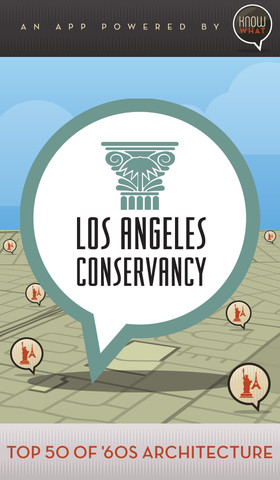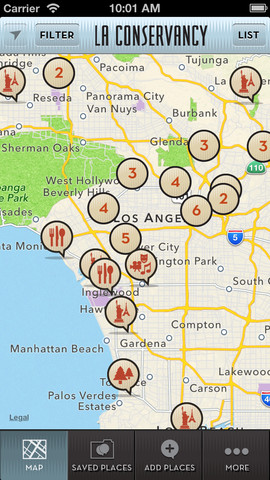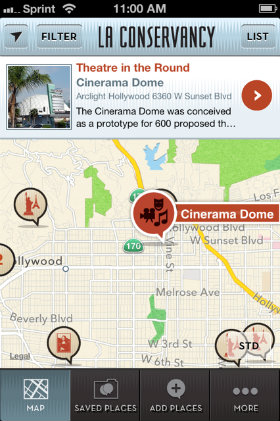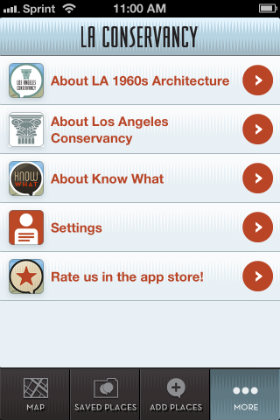Apps are on every organization’s radar these days. But, as Cindy Olnick of the LA Conservancy points out, "it's a balancing act to try new things without randomly jumping on bandwagons." AAO spoke with Olnick about the LA 1960s Architecture app: the motivation behind it, how much investment was required, and what benefits they've seen so far.
AAO: Apps and other mobile friendly content solutions are on every organization’s radar screens these days. Tell us about the “LA 1960s Architecture” app. What service does it provide?
Cindy Olnick: A few years ago, the Conservancy mounted an educational program called The Sixties Turn 50, showcasing Greater L.A.’s rich legacy of architecture from the 1960s. We conducted a people’s choice poll, The Top 60 of the ‘60s, in which the public voted on their favorite local 1960s buildings in various categories (residential, commercial, etc.). The app is a mobile version of the Top 60 of the ‘60s that helps users visit these buildings and experience them firsthand—which is exactly what we want.


What have been the primary advantages the app presents to the Conservancy?
It helps us counter the misperception that historic preservation organizations are stodgy or stuck in the past. Even though we focus on buildings from the past, our goal is to keep them viable and useful today and for future generations. To stay relevant to people and engage new audiences, we need to go where they are—which, increasingly, is on their phones. Tools like this are a great complement to other tours. They certainly don’t replace our docent-led walking tours, but offer a completely different type of experience (we could never do a docent-led walking tour of 60 places throughout L.A. County!). And we reach some folks who might never even think of taking a docent-led tour.



The idea for this app originated from a source outside the LA Conservancy. Can you tell us about your project partner?
We knew we needed to explore mobile apps, since the concept is perfect for experiencing great architecture. But we didn’t have the time, expertise, or resources to pursue building an app. Luckily, we were contacted by a developer looking for content for a new app called Know What, which offers a series of curated guides to cool places in Los Angeles. We gave them content we already had from the Top 60 poll, and they took care of the rest. They coordinated the initial launch and keep improving the app with new features, which keeps it fresh.
Escape Apps was great to work with and I’d encourage anyone looking to get their feet wet with apps to get in touch with them.
So how much did it cost you, and have you seen much financial return?
It didn’t cost us anything but the time needed to work out the agreement and refresh the content. We haven’t made a ton of money, but I’m learning that we shouldn’t really expect to through new media. We’re seeing the same with Facebook and other social media, which is more of a way to raise awareness and engage people than directly make money.
Besides the obvious cost benefits and the tech know-how, were there other advantages to working with an outside vendor?
If we had created the app ourselves, we likely would have focused on an overall “greatest hits” of historic L.A. architecture—and we’d probably still be writing content for it! An outside vendor brought a fresh perspective on what would be fun for users, as well as some accountability to get it launched in a reasonable amount of time. So we used existing content and ended up with (I think) a really cool app that goes beyond the usual suspects in terms of L.A. architecture.


Program development is hard work no matter the project size. How much time did it take to get this operational?
Even though we worked with existing content, as you know, most projects—especially new ventures—take about three times longer than you first expect. This took about nine months from our first meeting until the launch of the first version of the app, but the delays were all ours. It took about six months to iron out the contract because it was such new territory for us. After the initial launch, we changed the app and pricing structure, so there’s some ongoing administration that doesn’t take terribly long. What takes the most time is marketing and promotion. Since so many apps are released every day, any one app only has a brief window of time to shine as a new release before all the others come along to replace it. So to really make it successful takes heavy and ongoing promotion.
I think the biggest single challenge was making this project a priority among everything else we have going on. It was an opportunity that came up to try something new, which we wanted and needed to do, but we still had all of our other work responsibilities and deadlines.
Also, what some might consider a challenge, but I really like, was the need for extreme brevity in the content for the app. I’m a big fan of brevity anyway, so it was great to have such tight word limits. And we had to think differently about which words to use for the medium and the audience—it was a great exercise in narrative and context.
Do you have any parting words of advice for our readers who might be considering launching an app for their own architectural organizations?
Don’t fear the app! But do understand that it does take a commitment of time, thought, and energy to do it right. Technology changes so fast that at this point, you can make your own app using another app.
We all need to do what we can to explore new ways to advance our missions. It’s a balancing act to try new things without randomly jumping on bandwagons. Maybe a smart, dedicated volunteer could spend some time looking into this for you if you give them some direction about your goals, priorities, and limits. And it’s really hard for me to say this, but don’t be afraid to fail. Not everything will work out of the gate. But it doesn’t have to be perfect to be a worthwhile experience that you can learn from.
The Conservancy has been investing (time, mainly) in social media for several years now, and we’re hardly on the cutting edge, but we do our best to at least keep pace in a way that makes sense for us. We just try to stay focused on why we’re doing all these things: to engage more people in the important work of saving L.A.’s great historic places.


